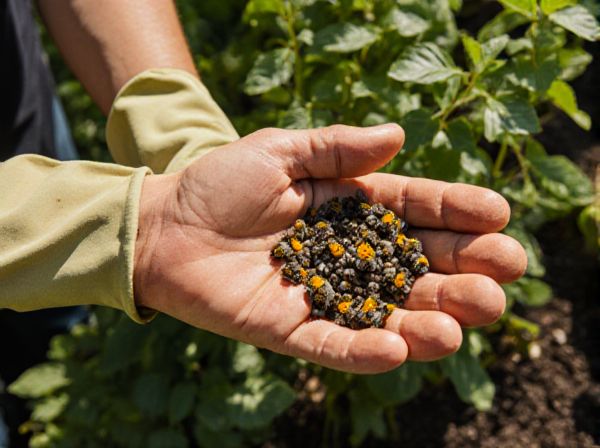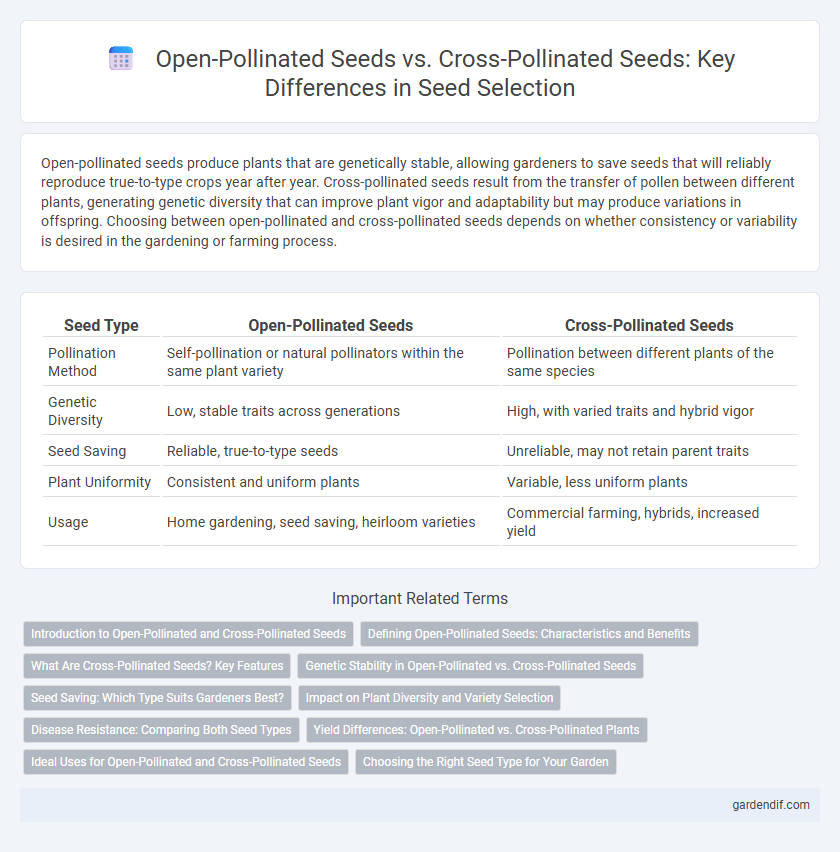
Open-pollinated seeds vs Cross-pollinated seeds Illustration
Open-pollinated seeds produce plants that are genetically stable, allowing gardeners to save seeds that will reliably reproduce true-to-type crops year after year. Cross-pollinated seeds result from the transfer of pollen between different plants, generating genetic diversity that can improve plant vigor and adaptability but may produce variations in offspring. Choosing between open-pollinated and cross-pollinated seeds depends on whether consistency or variability is desired in the gardening or farming process.
Table of Comparison
| Seed Type | Open-Pollinated Seeds | Cross-Pollinated Seeds |
|---|---|---|
| Pollination Method | Self-pollination or natural pollinators within the same plant variety | Pollination between different plants of the same species |
| Genetic Diversity | Low, stable traits across generations | High, with varied traits and hybrid vigor |
| Seed Saving | Reliable, true-to-type seeds | Unreliable, may not retain parent traits |
| Plant Uniformity | Consistent and uniform plants | Variable, less uniform plants |
| Usage | Home gardening, seed saving, heirloom varieties | Commercial farming, hybrids, increased yield |
Introduction to Open-Pollinated and Cross-Pollinated Seeds
Open-pollinated seeds result from natural pollination within the same plant variety, producing offspring genetically similar to the parent plants and maintaining trait consistency. Cross-pollinated seeds arise from the transfer of pollen between different plants, enhancing genetic diversity and often leading to more vigorous and adaptable crops. Choosing between open-pollinated and cross-pollinated seeds impacts seed saving practices, crop uniformity, and adaptability to changing environmental conditions.
Defining Open-Pollinated Seeds: Characteristics and Benefits
Open-pollinated seeds are produced through natural pollination methods such as wind, insects, or self-pollination, maintaining genetic consistency across generations. They exhibit stable phenotypic traits, allowing gardeners to save seeds with predictable characteristics, promoting biodiversity and plant adaptation to local environments. These seeds are often favored for sustainable agriculture due to their resilience, cost-effectiveness, and preservation of heirloom varieties.
What Are Cross-Pollinated Seeds? Key Features
Cross-pollinated seeds result from the transfer of pollen between different plants, promoting genetic diversity and stronger offspring. These seeds exhibit increased vigor, adaptability, and resilience to diseases compared to self-pollinated seeds. Commonly found in crops like corn, cucumbers, and squash, cross-pollinated seeds help maintain healthy plant populations through natural genetic variation.
Genetic Stability in Open-Pollinated vs. Cross-Pollinated Seeds
Open-pollinated seeds maintain high genetic stability by producing offspring genetically similar to the parent plant, ensuring consistent traits across generations. Cross-pollinated seeds exhibit greater genetic variability due to the mixing of different parent plants' genes, leading to diverse characteristics in the progeny. This genetic diversity in cross-pollinated seeds can enhance adaptability but reduces uniformity compared to the stable genetics found in open-pollinated varieties.
Seed Saving: Which Type Suits Gardeners Best?
Open-pollinated seeds produce plants that grow true to type, making them ideal for seed saving as gardeners can reliably harvest seeds that will perpetuate consistent traits year after year. Cross-pollinated seeds result from the mixing of different plants, leading to genetic variation and reducing predictability in saved seeds, which may not retain desired characteristics. Gardeners focused on maintaining stable plant varieties and harvesting viable seeds for future planting often prefer open-pollinated seeds for their reliability and ease of seed saving.
Impact on Plant Diversity and Variety Selection
Open-pollinated seeds promote genetic diversity by allowing plants to reproduce naturally, preserving unique traits and adapting to local environments, which benefits long-term biodiversity. Cross-pollinated seeds enhance variety selection through controlled breeding, producing hybrids with specific desired characteristics such as higher yield or disease resistance, but may reduce genetic variability. Balancing both seed types supports sustainable agriculture by maintaining diverse genetic pools while enabling targeted improvements in crop performance.
Disease Resistance: Comparing Both Seed Types
Open-pollinated seeds often exhibit stable disease resistance due to their genetically diverse populations, which enhances adaptability to local pathogens. Cross-pollinated seeds tend to have increased genetic variability, resulting in higher potential for resistance but less predictability across generations. Understanding the disease resistance traits of each seed type helps optimize breeding strategies for crop resilience.
Yield Differences: Open-Pollinated vs. Cross-Pollinated Plants
Open-pollinated seeds produce plants that exhibit stable traits and often lower yield consistency compared to cross-pollinated plants, which benefit from genetic diversity leading to higher and more robust yields. Cross-pollinated plants typically harness hybrid vigor, resulting in increased productivity, disease resistance, and adaptability to varied environmental conditions. Yield differences stem from the genetic variation in cross-pollination, providing a significant advantage in agricultural performance over uniform open-pollinated varieties.
Ideal Uses for Open-Pollinated and Cross-Pollinated Seeds
Open-pollinated seeds are ideal for gardeners seeking consistent, true-to-type plants for saving seeds and maintaining heirloom varieties. Cross-pollinated seeds suit commercial growers aiming for hybrid vigor, increased yield, and disease resistance due to genetic diversity. Choosing the seed type depends on whether the priority is genetic stability or enhanced plant performance.
Choosing the Right Seed Type for Your Garden
Open-pollinated seeds produce plants that breed true to type, offering consistent traits and stable genetics ideal for gardeners seeking predictable harvests and the ability to save seeds year after year. Cross-pollinated seeds result in plants with greater genetic diversity, often leading to hybrid vigor but less uniformity, which can be advantageous for enhancing disease resistance and adaptability in varied environments. Selecting between open-pollinated and cross-pollinated seeds depends on your garden goals, such as maintaining heirloom varieties or optimizing for robust, high-yield crops.
Open-pollinated seeds vs Cross-pollinated seeds Infographic

 gardendif.com
gardendif.com